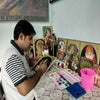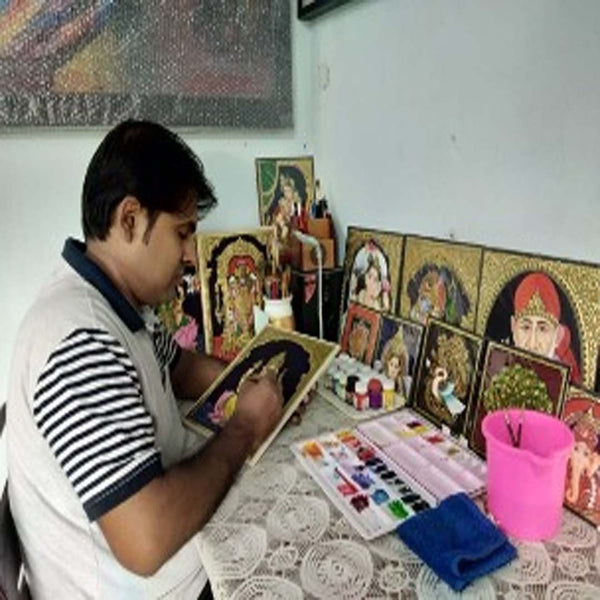Tanjore
Tanjore art, also known as Thanjavur painting, is a classical South Indian art form that originated in the town of Thanjavur (Tanjore) in Tamil Nadu, India. Known for its rich colors, surface richness, compact composition, and the use of gold foil, Tanjore paintings are celebrated for their vibrant portrayal of Hindu deities. These paintings are not just visual delights but also embody spiritual depth, often used in worship and as symbols of devotion. With their distinct three-dimensional effect and intricate detailing, Tanjore paintings continue to captivate art lovers and collectors around the world.
The primary themes of Tanjore paintings revolve around Hindu mythology, focusing on deities such as Krishna, Ganesha, Lakshmi, Saraswati, and Shiva. Scenes from epics like the Ramayana, Mahabharata, and Puranas are also popular. These paintings often depict the deities in a majestic and divine manner, with rich adornments, elaborate jewelry, and vibrant backgrounds that reflect a sense of grandeur and spirituality. Occasionally, themes may extend to portray saints, cultural figures, or even royal portraits, but the central focus remains on religious and devotional subjects.
History
The history of Tanjore art dates back to the 16th century during the reign of the Nayak rulers, who were great patrons of art and culture. This art form flourished under the patronage of the Maratha rulers in the 17th and 18th centuries. The Marathas brought in artists from Maharashtra and mixed their style with the local artistic traditions, resulting in the distinctive Tanjore style. Over the years, the art evolved, incorporating influences from various cultures, including Deccani, Vijayanagara, and Maratha art, while retaining its core characteristics of opulence and devotion. The paintings were traditionally made for temples and used as a medium to spread stories from Hindu mythology among the masses.
Materials and Methods
The process of creating a Tanjore painting involves multiple stages and the use of a variety of materials. The base is typically a wooden plank or a cloth pasted onto wood, coated with a mixture of chalk powder and a binding agent to create a smooth surface. The artist then sketches the image using charcoal or pencil. Relief work is done using a paste made of limestone and a binding medium, which is applied to areas like jewelry to give a raised effect. The painting is then colored with natural pigments, and the final touch involves the application of gold leaf, which is carefully pressed onto the raised areas and other parts of the painting. This use of gold leaf not only adds to the aesthetic appeal but also ensures the painting's longevity, as the gold does not tarnish over time.
Tanjore paintings are easily recognizable by their rich, vivid colors, robust composition, and the liberal use of gold leaf to create a sense of luminosity. The figures are usually depicted in the center, set against an elaborate background that often includes arches, curtains, and pillars, giving a royal appearance. A distinctive feature of Tanjore art is the use of relief work, where parts of the painting, like the jewelry and adornments, are raised to give a three-dimensional effect. The faces in Tanjore paintings are generally round and expressive, with large eyes that convey a sense of divinity and grace.
Significance
Tanjore art holds significant cultural and spiritual value, representing the artistic heritage of South India. It is revered not only for its beauty but also for its role in religious and cultural expression. Traditionally, these paintings were used as devotional icons in homes and temples, believed to bring blessings and prosperity. Beyond their religious significance, Tanjore paintings are also appreciated for their intricate craftsmanship and historical value, offering a glimpse into the artistic sensibilities of the past. Today, Tanjore paintings are recognized globally as exquisite pieces of traditional Indian art, symbolizing a rich legacy that continues to be preserved and celebrated. Efforts to sustain this art form include workshops, exhibitions, and educational initiatives, ensuring that the techniques and traditions of Tanjore art are passed down to future generations.
FAQs
What is the significance of gold in Tanjore paintings?
The use of gold in Tanjore paintings is not just for aesthetic appeal but also holds cultural and spiritual significance. Gold is associated with divinity, prosperity, and auspiciousness in Indian culture. In Tanjore art, the gold foil adds a luminous, almost three-dimensional quality to the paintings, symbolizing the divine light that emanates from the deities depicted.
How do I care for a Tanjore painting?
To care for a Tanjore painting, it’s important to keep it in a dry, cool place, away from direct sunlight and moisture, which can damage the gold foil and colors. Dust the painting gently with a soft, dry cloth. If framed, ensure the frame is sealed properly to prevent dust and moisture from entering.
Can Tanjore paintings be customized?
Yes, Tanjore paintings can be customized according to personal preferences, including the choice of deity, size, and specific design elements. MeMeraki offers customized Tanjore paintings to suit modern decor while retaining the traditional essence of the art form.
![]() Get Upto 10% OFF on purchase of this product.
Get Upto 10% OFF on purchase of this product.
![]() Get upto 10% OFF on Live Workshops when sign up for 2 or more workshops.
Get upto 10% OFF on Live Workshops when sign up for 2 or more workshops.
![]() Get 10% OFF coupon code for Art Kits signing up for Masterclass or Live Workshop.
Get 10% OFF coupon code for Art Kits signing up for Masterclass or Live Workshop.
![]() Earn upto 7,750 Points on purchase of this product.
Earn upto 7,750 Points on purchase of this product.











